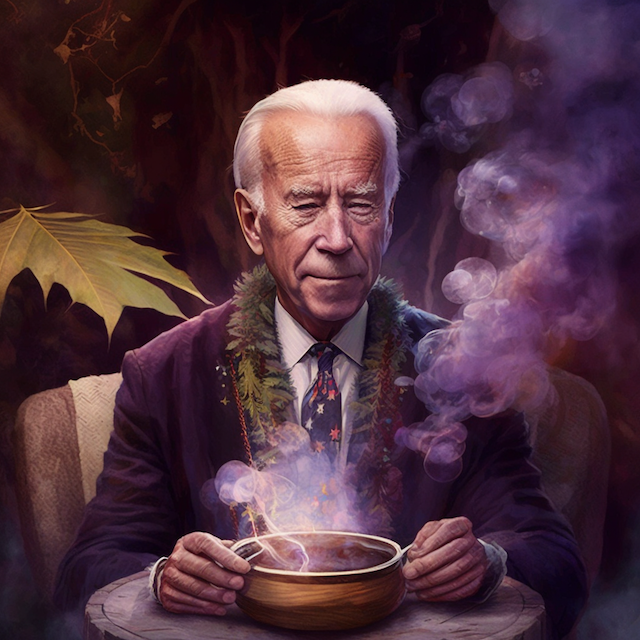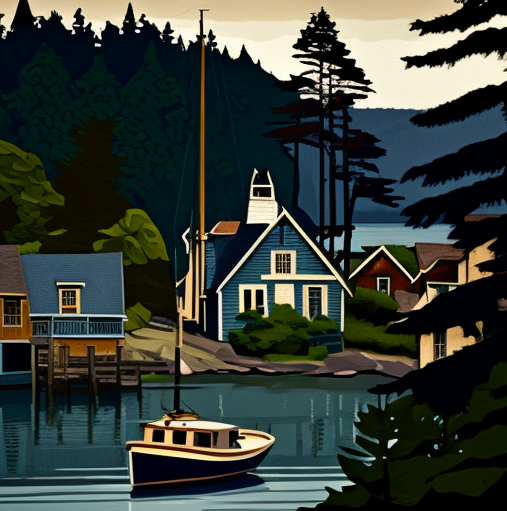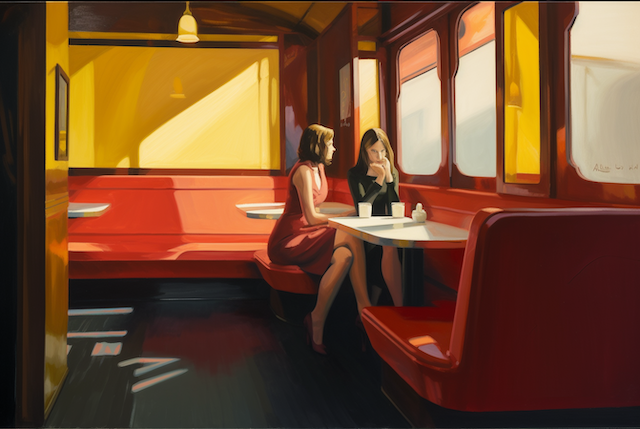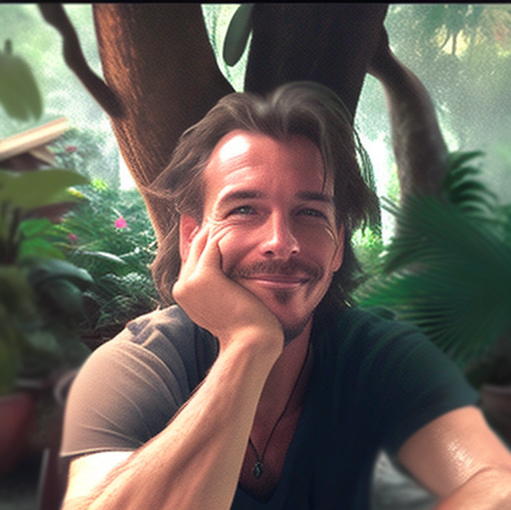
I‘ve been playing with one of the new AI bots called Midjourney, which is specifically oriented toward the creation of images — ranging from the photorealistic to the abstract. I’m still working on an older version which lacks some of the more sophisticated features of the newest one, but it’s still amazing. Midjourney produced the image above from a very simple prompt (“/imagine Joe Biden doing ayahuasca”). (Might want to loosen the tie a bit, Joe.)
The tool basically draws on every image publicly available on the internet, and every tag, and on its rendering engine. It’s as astonishing in its own way as Shazam was when it came out and solved the problem of identifying recorded music you hear in public places (or on radio stations and in music mixes that don’t list each song played). What it does, seems impossible, but it really isn’t all that difficult with such an enormous set of data to draw upon.

The image above, for example, came from my prompt “/imagine a painting of Snug Cove on Bowen Island in the style of Modigliani”. Not sure it’s his style, but it is striking. Here’s the more interesting result of a prompt “/imagine inside a French cafe, 1970, 2 Parisian ladies, in the style of Edward Hopper”:

I have a good friend who’s become quite the sensation with her acrylic works portraying our local landscapes. I asked Midjourney for a painting of Howe Sound done in her style and the results were mind-blowing. I think I’ve seen all her works, and the Midjourney images don’t portray the same landscapes, but damn, it sure could have been her work. If I get the OK from her, I might post a couple of her works here and then show some of Midjourney’s imitations. Whew!
You can also prompt Midjourney to use a particular image (either one online or one you upload) as a starting point, adding additional prompts for style and content. Being an incurably vain person, I asked Midjourney for a painting of me in a jungle setting, prompting with my photo from this blog’s right sidebar. Here’s what it provided in response:

I learned a lot from studying the prompts of other users. As there seem to be a lot of anime and J-Pop/K-Pop fans among Midjourney’s users, I couldn’t resist asking Midjourney to make me over as a K-Pop star. Here’s the result:

OK, so the tool is fun to play with (instructions at the end of this post if you want to try it). But what does it mean for the arts? Here are my early thoughts:
- If you use a lot of online images, and have been using CC0 sites to get images that are unconditionally free, you now have another option. Like Indrajit Samarajiva, I may well use Midjourney to create most of the images for my blog posts from now on. But many thanks to Pexels, Pixabay and the other CC0 sites for being there for us, and I will probably continue to scan them; they might also start putting Midjourney images on their sites, for those not interested in creating their own.
- I think there’s a huge commercial opportunity for someone to offer to make high-quality prints and frames for Midjourney images. I’ve bought a few DeviantArt images over the years, and may well want to frame and hang some Midjourney images as well. There are a lot of Midjourney users using the tool to produce advertising and marketing materials already.
- I can see tools like this transforming the visual arts media in much the same way that tools like GarageBand, ProTools, Ableton and LogicPro have transformed music creation. Professional artists will survive, though they will probably have to learn some new skills to keep up. The situation for professional photographers is much more precarious, especially with vultures like Getty cornering so much of their work at outrageous royalty rates. I for one will be delighted if the vultures are disintermediated right out of business. But photographers who depend on royalties or salaries from mainstream media may get caught in the crossfire. On the other hand, I think cartoonists will do OK.
- AI isn’t only affecting the graphic arts; it’s affecting all the arts. AI tools are already producing written works, from poetry to novels, that some say cannot be differentiated from ‘human-made’ writing, especially in some of the more popular, more formulaic genres (romance, spy thrillers, murder mysteries, some young adult genres). I understand that there are products under development that will do for music creation and film creation what Midjourney does for visual arts and photography.
- The possibilities for ‘fake photography’ being used as part of mis- and disinformation campaigns is soaring, and tools like this will worsen the situation. The Joe Biden image above was created as a painting, but it could just as easily have been produced to look exactly like a photograph. A photo of Donald Trump apparently personally paying off Stormy Daniels would be dead simple to produce with tools like this. We may soon start to doubt the authenticity of every photo we see.
- The lawyers must be reeling. They’re already 50 years behind in intellectual property laws, and this will crush them. Google is apparently already working on an algorithm that will somehow determine the line between plagiarism and original work, as if ‘sampling’ in music hadn’t already obliterated that line. Certificates of authenticity may continue to protect rare, high-value original works of art, but for everything else, I can’t see IP laws on creative works holding up in any but the most egregious cases.
- As for teachers of the arts, and of any subject requiring written work submission for grades or scholarships, their job of detecting and punishing plagiarism just got much, much harder. I just read a very well-polished blog that recommends and explains how to use products in a variety of niches, with “affiliate links” from which it earns commissions. It is entirely produced by AI. The owner even has a course that teaches you how to do the same. Good thing this blog could never be replaced by AI, right? Right?
PS: If you’re interested in playing with Midjourney yourself, be forewarned that the free trial gives you just enough free image generations (25, though I think it gave me more than that), to get you hooked before you have to sign up for a membership ($10/mo for 200 images/month). Though you can just scroll through what other newbies or members have been creating, and you can download their results, without limit.
To access Midjourney, you need to sign up for the Discord platform (free, and kind of interesting in itself, for those unhappy with other social media platforms, though it’s had its share of controversy). Then you go to the Midjourney site, and ask for an invitation to the Midjourney server on Discord, and you’re set. You really only need to know the /imagine and /blend commands, and study what others on the server have posted as their (mostly one-line) prompts, and then start entering your own. If you want to include a starter image in your prompt, enter the URL(s) of the image(s) at the start of your /imagine prompt, and then add your other form and content criteria. It’s pretty simple.





Spoiling arts is only mildly annoying, spoiling Science and Education much more so.
Here’s my MJ page, if you’re interested
https://www.midjourney.com/app/users/b0f2b82a-8893-4b23-928d-95df3800a0d3/
Also, if you type “/info” you’ll get your stats and a link to your own web page
Ugh. I’ll admit upfront to being openly hostile to computer-generated “art” in any genre. There’s an aesthetic response you get at by grading the output and observing that the ability to distinguish human creativity from its algorithmic imitation is diminishing as the imitations get better. Same thing with the Turing Test and chatbots, though this postmodern situation is really a statement about human susceptibility to being duped and fooled than the sophistication and worthiness of the output, whether as genre fiction, marketing fodder, or college term papers.
The thing that really horrifies me, however, it the ongoing race toward falsification of reality. We are already in a position (if thinking at all clearly) of disbelieving the authenticity of just about everything seen, heard, felt, and understood. How can we act with integrity when confronted with such a hall of mirrors? Others may thrill at emerging realms of fake or simulated experience, but I retreat into an earnest desire to secure my ability to make sense of the world amid a constant stream of gaslighting. Through a glass darkly.
Thanks Brutus. Yes, for sure, we can now be kept permanently off-balance by doubting the credibility and authenticity of everything we read, see and hear, which serves some people’s interests quite well. Oh wait, that might be a conspiracy theory. Strawberry Fields Forever.
Just got sent an article in WaPo from a young woman “journalist” suggesting that climate “doomers” (apparently there is only one flavour) are more deluded and dangerous than climate deniers, and that IPCC says there’s lots of time and it’s just a manageable risk. But it’s in WaPo so it must be correct, right?